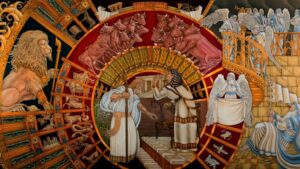More than three years after the Pittsburgh synagogue shooting, the deadliest attack on a Jewish community in U.S. history, Jewish organizations continue to grapple with questions about keeping Jewish spaces safe while creating a more inclusive and welcoming Jewish community.
Against this backdrop, the Jewish Museum of Maryland recently launched a multi-media art exhibition titled, “A Fence Around the Torah: Safety and Unsafety in Jewish Life.” The exhibition, which opened in early December, runs through Feb. 13.
(Due to the surge in COVID-19 cases in Maryland), “A Fence Around the Torah” was only viewable online at afencearoundthetorah.com for most of its run. However, the JMM announced today that it will re-open to the public on Sunday, Feb. 6 so that visitors will have a week to see the exhibition in-person before it closes. A video tour of the exhibition from curator-in-residence Liora Ostroff is also available. Please email info@jewishmuseummd.org if you would like to request one. Additionally, the museum will soon be releasing a podcast hosted by Director of Communications and Content Mark Gunnery, including interviews with featured artists and members of the exhibition’s curatorial panel.
It’s fair to say that “A Fence Around the Torah” would likely not exist if not for the pandemic, say the exhibition’s organizers.
“The space to stage this exhibit was created through an opening in the schedule of the Feldman Gallery at the Jewish Museum of Maryland, as exhibit schedules were shifting due to COVID,” said JMM Executive Director Sol Davis. “We decided this was an opportunity to experiment with uncertainty wrought by the pandemic and its impact on arts and cultural organizations.”
But the exhibition goes well beyond discourse around safety issues as it pertains to health concerns and even antisemitism-fueled violence.
“The exhibition’s exploration of the central and unifying theme of safety in Jewish life is intended to expand and deepen communal conversations beyond the important conversations taking place about physical safety to include emotional harm, moral injury, symbolic violence and more,” said Davis.
To bring “A Fence Around the Torah” to fruition, Davis partnered with Ostroff, a local artist. He also worked with such community organizations as Hinenu: The Baltimore Justice Shtiebl, the Baltimore American Indian Center and Heritage Museum, and the Baltimore Jews of Color Community Havurah to present a series of community conversations on topics related to the exhibition’s themes. These included reimagining Jewish futures with Rabbi Jessy Dressin; queer life and Judaism with Dr. Harriette Wimms; policing and security with Rabbi Ariana Katz of Hinenu; safety in Orthodox life with Tikvah Womack and racial justice with Jennifer Folayan.
Ostroff said these conversations were emblematic of the type of conversations taking place in her own Jewish community.
“I found that in my community, Hinenu, the conversations we had about safety were framed differently than in other communities,” she said. “The idea of using generative questions, questions that we can ask ourselves to better understand our own experiences, questions that really allow us to imagine how the world can be different, became the framing for this whole project.”
Davis and Ostroff also consulted with a curatorial panel consisting of representatives from national organizations including the Council of American Jewish Museums, the New Jewish Culture Fellowship, the Jewish Theological Seminary, the Laboratory for Jewish Culture and the Jews of Color Mishpacha. These organizations helped select the works chosen for inclusion in the exhibition.
Ostroff said the exhibition’s title comes from Pirkei Avot (Ethics of the Fathers) in which Jews are instructed to construct a fence around the Torah to protect the values and ethics of Judaism.
Still, fences can also signal exclusion and may engender feelings of unsafety. As Ostroff wrote in her curatorial statement, the works in the exhibition “highlight the internal conflict over safety and exclusion within Jewish communities and institutions. This work includes personal reflections on queer life and Judaism, racial justice in Jewish spaces, cultural loss and reclamation, political dialogues and dissent, mythological narratives around unsafety, and dreams for inclusion and solidarity coming from within Jewish institutions and the organized Jewish community.”
The exhibition features the works of 15 artists: Marisa Baggett; Coral Cohen; Danielle Durchslag; Hannah Aliza Goldman; Nicki Green; Judith Joseph; Joy Ladin; Annabel Rabiyah; Rosabel Rosalind; Val Schlosberg; Katz Tepper; Arielle Tonkin and Daniel Toretsky; Ami Weintaub and Naomi Weintraub. The artists work in a variety of media including painting, drawing, woodblock print, video, poetry, graphic design, ceramic and textile.

(Provided by Jewish Museum of Maryland)
In addition, the exhibition features a radio play, recipes and an outdoor, site-specific installation in the JMM’s courtyard titled, “We Would Come Home But You’ve Locked the Door.”
Davis said he hopes visitors come away from the exhibition “thinking in new ways about the central questions the exhibit poses: what makes you feel safe? When does what makes you feel safe make others feel less safe?”
He believes “A Fence Around the Torah,” which is his first exhibition since coming to the JMM in January of 2021, “holds the potential to shift and expand communal conversations about safety while increasing people’s understanding about the precarity that some members of the community experience and others are not aware of.”
For information about the JMM and this exhibition, visit afencearoundthetorah.com.


